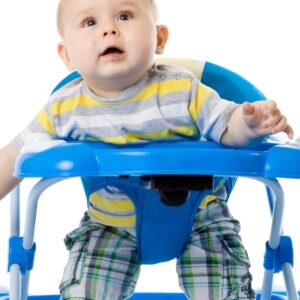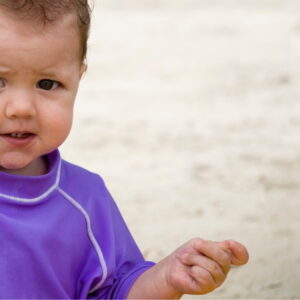What if your baby is crying without producing tears? Can this really be normal? Well, it can. Sort of. Let’s take a look at babies’ tear production and when you should expect to see tears in your baby’s eyes.

Mom’s Question:
My baby cries, but no tears appear; what is wrong? Is something wrong with his eyes? They don’t seem unusual in any way, but it can’t be normal for a baby not to have tears, or can it?
Thanks,
Danielle
Baby Crying Without Tears: Causes and What to Do as a Parent
Do Babies Cry With Tears Or Not?
Although it may not be so obvious, newborn infants do produce tears while crying. The amount of tears, however, is much less than what is seen in older infants. In addition, premature infants produce even fewer tears than full-term infants. Many more tears are apparent after two weeks for full-term infants and four weeks for preemies. Maximum tear production occurs by age two months. Tears are not just for crying but also play an important role in keeping the eyes healthy.
Where Do Tears Come From?
Tears are produced by the lacrimal gland, located within the outer portion of the upper eyelids. When tears are released from this gland, they flow over the eye and are collected into a tear duct that lies along the inner corners of the eyes and the bridge of the nose. This lacrimal duct drains into the nose and is why a runny nose is often associated with crying.
Tears are primarily salt and water, along with a smaller amount of fatty acids, mucous, and protective antibodies. This composition lubricates the eye and protects it from irritation. Crying, in a sense, “flushes” the eye, helping to remove any irritants.
Several components of the nervous system control the release of tears from the lacrimal gland. The sympathetic nervous system responds when an infant is startled or frightened, The parasympathetic nervous system causes an infant to cry when feeling cold, hungry, or in pain. Facial nerves near the eyes control the amount of tears that are produced.
Conditions That May Affect Tear Production
There are several medical conditions that are associated with decreased tear production or collection.
Dehydration
Infants can become dehydrated when they are unable to feed well or are losing body fluids due to an illness. While feeling sick, they often take less breastmilk or formula. If they develop a fever, fluid is lost from sweating and breathing more rapidly. Vomiting and diarrhea can exacerbate the loss of body fluid. The first sign of dehydration is a reduced number of wet (urine) diapers. If ongoing fluid losses are not replaced, dry lips and an absence of tears while crying may be evident. Sunken eyes, lethargy, or increased irritability are signs of severe dehydration that require emergency medical treatment.
Clogged Tear Ducts
It is common for newborns to have a temporary obstruction of the duct that drains tears from the eyes into the nose. In most cases, the lacrimal duct is blocked by a membrane at birth that takes a few days to open. In other cases, there is a problem with the duct itself, usually due to immature development. This causes pooling of tears at the inner corner of the eye. At times, a white mucous may form that can be easily wiped away. This differs from the kind of mucous that forms during an eye infection which is typically yellow or green.
A clogged lacrimal duct may affect one or both eyes. It can be managed by gently massaging the tear duct with a warm moist cloth a few times per day. This technique can be demonstrated by your pediatrician, and it helps to reduce the accumulation of mucous. Over time, the lacrimal duct begins to drain tears from the eye properly. In 90 percent of cases, this condition goes away by the first birthday. When it persists, surgical release of the obstruction is recommended.
Conjunctivitis
Conjunctivitis is the general term for inflammation of the surface of the eye. It may caused by a viral or bacterial infection. Some infections are transmitted from the mother during childbirth, while others are community acquired.
It is important that such infections be detected and treated early to prevent them from spreading throughout the body. Bacterial conjunctivitis is treated with antibiotic eye drops. If fever or other symptoms are present, oral antibiotics may be necessary. Herpetic conjunctivitis is managed with antiviral medication.
Congenital Alacrima
When the lacrimal gland fails to develop during fetal life, this can result in the absence of tears. This very rare occurrence can be an isolated finding or one component of another genetic disorder. Because of there is no lubrication from tears, the eye is prone to dryness and inflammation. Some examples of medical conditions that are associated with alacrima are Allgrove syndrome, ectodermal dysplasia, and Riley Day syndrome. These infants and children cry, but never with tears.
Allgrove syndrome
Also known as “Triple A” syndrome, this condition is characterized by dysfunction of the adrenal glands, poor motility of the esophagus, and lack of tears. The nerves and lacrimal gland cells responsible for the release of tears are dysfunctional due to a genetic mutation. The lack of tears increases the risk of scarring of the cornea. Quality of life is more affected, however, by the insufficient adrenal gland hormones.
Ectodermal Dysplasias
There are over 180 types of ectodermal dysplasias that involve abnormalities of the hair, skin, teeth, and nails. The lacrimal, salivary, and sweat glands are also affected. Prior to birth, a variety of genetic mutations cause the outer layer of the embryo to develop abnormally. As a result, these infants and children have dry eyes, a dry mouth, abnormally-shaped teeth, and do not sweat. In addition to corneal irritation, lacrimal duct obstruction, cataracts, vision problems, and abnormally shaped eyes are common.
Riley Day Syndrome
This condition can affect infants and children of Ashkenazi Jewish ancestry. In addition to the absence of tears, it is associated with difficulty swallowing, seizures, bowel problems, and impaired taste, pain, and temperature sensation. Eye problems include decreased sensation and pupil reaction as well as corneal scarring from the absence of tears.
Pediatric Dry Eye
There are normal situations in which the eyes may begin to produce fewer tears or tears with an altered composition.
During the “lockdown” period of the CoVID-19 pandemic, children spent more time indoors and often in front of screened devices. Prolonged screen time has been associated with eye dryness because of less frequent blinking.
Other common causes of childhood dry eye are medications such as for acne or allergies and contact lens use. Some studies have shown that environmental allergens and pollutants can alter the amount of mucous or fatty acids in tears.
What Should Parents Do?
During the first few days of life, parents should not expect to see copious amounts of tears while their newborn cries. Small amounts of tears should be evident after the first two weeks and significantly more by age two months. However, if an eye discharge or signs of irritation are present, parents should schedule a doctor visit. If the baby is born with any facial abnormalities, evaluation for lacrimal gland or duct problems is a good idea. This may be done in the hospital before the newborn is discharged home.
When To Discuss The Lack Of Tears With Your Child’s Doctor
Parents should be concerned about the lack of tears if:
- No tears by two months old
- Baby has an abnormal eye shape
- Eyes frequently appear irritated
- Baby was born with a cleft palate/lip
- No tears with a fever, vomiting, or diarrhea
Conclusions
Most babies produce tears. Look closely the next time your baby cries. If the eyes appear dry and irritated, contact your pediatrician. There are medical conditions associated with a lack of or a reduced amount of tears, but they are very rare. If you are concerned that something may not be right about your baby’s eyes, it is best to have them checked by a doctor.
I hope this helps!
Paula
References:
- Isenberg SJ, Apt L, McCarty J, Cooper LL, Lim L, Del Signore M. Development of Tearing in Preterm and Term Neonates. Arch Ophthalmol. 1998;116(6):773–776. doi:10.1001/archopht.116.6.773
- Toker E, Yenice O, Oğüt MS, Akman I, Ozek E. Tear production during the neonatal period. Am J Ophthalmol. 2002 Jun;133(6):746-9. doi: 10.1016/s0002-9394(02)01393-4. PMID: 12036663.
- Chang AY, Purt B. Biochemistry, Tear Film. [Updated 2022 Jun 11]. In: StatPearls [Internet]. Treasure Island (FL): StatPearls Publishing; 2023 Jan-. Available from: https://www.ncbi.nlm.nih.gov/books/NBK572136/
- Machiele R, Lopez MJ, Czyz CN. Anatomy, Head and Neck: Eye Lacrimal Gland. [Updated 2022 Jul 25]. In: StatPearls [Internet]. Treasure Island (FL): StatPearls Publishing; 2023 Jan-. Available from: https://www.ncbi.nlm.nih.gov/books/NBK532914/
- Tindle J, Tadi P. Neuroanatomy, Parasympathetic Nervous System. [Updated 2022 Oct 31]. In: StatPearls [Internet]. Treasure Island (FL): StatPearls Publishing; 2023 Jan-. Available from: https://www.ncbi.nlm.nih.gov/books/NBK553141/
- Perez Y, Patel BC, Mendez MD. Nasolacrimal Duct Obstruction. [Updated 2023 Jan 31]. In: StatPearls [Internet]. Treasure Island (FL): StatPearls Publishing; 2023 Jan-. Available from: https://www.ncbi.nlm.nih.gov/books/NBK532873/
- Inada N, Shoji J, Yamagami S. Infantile Acute Conjunctivitis Induced by β-Lactamase-Positive Amoxicillin-Clavulanate-Resistant Strain of Haemophilus influenzae: A Report of Three Cases. Eye Contact Lens. 2019 May;45(3):e11-e14. doi: 10.1097/ICL.0000000000000556. PMID: 30489345; PMCID: PMC6493690.
- Maqsood N, Mahmood U. Herpes simplex ophthalmia neonatorum: a sight-threatening diagnosis. Br J Gen Pract. 2020 Oct 1;70(699):513-514. doi: 10.3399/bjgp20X712973. PMID: 33004377; PMCID: PMC7518920.
- Ectodermal Dysplasia | National Institute of Dental and Craniofacial Research (nih.gov)
- Pediatric Dry Eye – American Academy of Ophthalmology (aao.org)
Find comments below.

Paula Dennholt founded Easy Baby Life in 2006 and has been a passionate parenting and pregnancy writer since then. Her parenting approach and writing are based on studies in cognitive-behavioral models and therapy for children and her experience as a mother and stepmother. Life as a parent has convinced her of how crucial it is to put relationships before rules. She strongly believes in positive parenting and a science-based approach.
Paula cooperates with a team of pediatricians who assist in reviewing and writing articles.







Hello there, I’ve a seven-year-old son who has never shed a tear even when he’s really, really hurt. His eyes could glisten when he’s hurt or upset but you never see the tears fall. Never have I wished in my life to see someone cry as I’ve done with him. I know that sounds horrible but I feel if he could cry out tears that will be a good indication that everything’s ok. He’s my first child, so when he was a baby I thought it was normal for babies not to shed tears when they cry. But his sister came along and sheds tears even when she’s a tiny little bit upset and so does my third child also.
I’ve also been told that is ok as long he’s got moisture in his eyes, and I try not to let it bother me but sometimes there’s this part of me that often wonders if all is well. If anyone ever finds out anything, pls don’t hesitate to post.
Cheers y’all. Here’s to the good health of our families.
My son has gone past his first bday without producing tears! We have just had a hospital appointment and have been told not to worry; his eyes are perfectly healthy & unless they go red & saw there is nothing to worry about.
We have been told that the tears may form lower down (than what I’m not sure) and maybe the majority of the wetness disperses (sorry my spelling is poor) through his nose.
We have been told to come back to the hospital in 3-6 months for another check-up but were told the problem should have corrected itself by then (but not to worry if it hasn’t).
I quite like it that my son doesn’t cry tears…..it means he’s happy ;0)
After I noticed my son wasn’t crying tears after age 1, I took him in. The local eye dr wasn’t concerned but I knew it wasn’t right and went with my gut to have it checked further.
By the time we got to the pediatric specialist, he said had it been left uncared for, he’d have probably been blind by the time he was in high school or at least partially. He immediately placed plugs in the lower lids to keep what moisture he does make from draining.
Contemplating doing the upper lids. This is very rare; hard to find anything on it. He calls it congenital alacrima, but my son is perfectly healthy other than he doesn’t cry tears. He’s now 3 years old, and we go every 6 months to make sure his eyes aren’t too dry and the plugs are still there and working.
But please push it, don’t settle for “that’s interesting but he’ll be ok” because had I, my son would be paying the price later on in life.
My daughter is almost 3, and she also has never shed a tear. Her eyes don’t get glassy or even get puffy. I took her to the eye doctor and they seemed shocked and told me to bring her back in 6 months. She has never had an infection in her eyes and has never had morning crust. They seem to be moist. It just seems very odd that when she is hurt or sad she doesn’t shed a tear. She is my 5th child and this is new to me. Her ped also said not to be concerned yet. But as a mother it’s hard not to worry.
My baby is 9 months old and still no tears. He had conjunctivitis a month ago, but it healed quickly (he caught it from daddy). I’m seeing a new doctor in a few days, hope to find good news.
hi, my name is Elena. I have a child who is almost 3 years old, and I’ve never seen his tears. Doctor said that is normal, but I’m still worrying.
This is the first time I’ve even seen a reference of any sort to this. My daughter is nearly 4 years old and has never made a tear in response to emotion. They don’t so much as even glisten, no puffiness, no redness – like they are simply not connected. Her ducts are fine, she has never had issues with dry eyes or flushing foreign bodies. Her doctors have never heard of this and it has remained a curiosity. We go to see a neurologist next month for an unrelated issue, I plan to bring this up just to see if they have any info at all. If we find anything out at all I’ll let y’all know…
Hi Danielle,
I am glad to hear that your doctor said it was normal as long as your 18 months old had his eyes moisturized. I have a 3 year old and he does not have tears either and the doctor told me the same thing. I feel relief that my son is not the only one in that situation
We have just been to the eye dr as my 18-month-old still hasn’t had tears. Apparently, it isn’t a problem, as his eyes still have moisture. He may not ever have tears which seems a little sad but it won’t cause him any harm.
My toddler is 17 months old and still cries, no tears. He has no eye infections or redness. He has been hurt a few times where his cry was “the hurt” cry.. and still no tears.
Hi, Danielle,
As a mother of six, I only had one infant that did not make tears naturally and eventually had to have his tear ducts opened.
Sometimes at birth, a small, thin flap of skin covers the area where tears drop from our eyes.
The tear ducts will often open on their own between birth and one year of age.
I understand that there is usually not a major concern if the tear ducts are not open unless the baby has reached his or her one-year birthday without tear production or if there is infection, swelling, or fever associated with the tear duct area.
Debbi
My baby is 26 months old and he never had a tear. His eyes are fine and even doctors say his eyes are normal. Somebody told me about Triple A syndrome. What is it? Is it dangerous?
Hi Saurabh,
Triple A syndrome is another name for “Achalasia Addisonianism Alacrimia syndrome”. It is an inherited condition, where absence of tears is one of the symptoms (alacrimia). Achalasia is a disorder that affects the ability to move food from the throat and down to the stomach. This leads to feeding difficulties. The third A stands for Addisonianism, or Addison’s disease, which has to do with abnormal function of some small hormone-producing glands on top of the kidneys.
The condition can be severe and needs treatment, but it is extremely rare, so it is not likely that your baby has it. The first symptom to show is usually lack of tears, which is probably why someone mentioned it to you. However, at least one more of the two other disorders need to be present too for the diagnosis.
You can certainly discuss Triple A with your child’s doctor, but again, it is not a likely reason for the lack of tears.
That said, I think it may still be wise to try to go the bottom with why your baby does not produce tears. I would recommend you to take your baby to a pediatric ophthalmologist to get it sorted out and to learn if he needs any type of treatment. It sounds good that the doctors’ say that his eyes are fine, but he still should be producing tears to moisturize the eyes.
Good luck, and please let me know how things develop!
This is the first place I have ever seen any reference to this. My son is six and has never cried tears, he hurts himself and cries out but no tears, not even in response to sadness. He does get very angry and has violent temper tantrums. I have thought that if he could cry he might not get so worked up.he is seeing a specialist in October at great ormand st for suspected autism so I shall bring it up then.
My daughter is 16 years old and had been labeled with Cerebral Palsy, low tone, small head, and developmental delay. She has just been diagnosed with a rare genetic disorder called N-Glycanase Deficiency or NGLY1. At this time (January 2015), she is just 1 of 21 children diagnosed with this worldwide. One of the main symptoms of this disorder is Alacrima or lack of producing emotional tears. Please don’t hesitate to contact us; we are parents who had been looking for answers as you have.